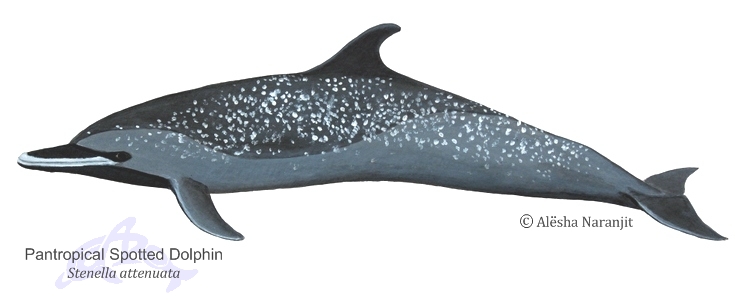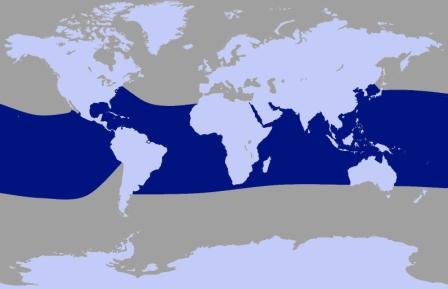
Classification Other Names: Spotted Dolphin, White-spotted Dolphin, Bridled Dolphin, Spotter, Spotted Porpoise, Slender-beaked Dolphin Suborder: Odontoceti Family: Delphinidae | Description There are two main forms of Pantropical Spotted Dolphin: the coastal form and the off-shore form. The coastal form is larger, more robust, with a thicker beak and is the more spotted of the two. Pantropical Spotted Dolphins are highly surface active and acrobatic and often bow- and wake-ride. They often associate with other oceanic cetaceans and yellow-fin tuna.
|
Pantropical Spotted Dolphin Ecology Range:Tropical and warm temperate waters between 40°N and 40°S Usual Habitat: Commonly occurs around islands, both off-shore and in-shore mainly in areas where the surface temperature is above 25°C Usual group size: 10 - 20 with superpods of 1000s of individuals Main Diet: Offshore populations are known to eat small fish, squid and crustaceans. Little is known about the diet of coastal populations but it may comprise of larger fish. Local population: Unknown | Global range of the Pantropical Spotted Dolphin  Pantropical Spotted Dolphins are likely to be found in the dark blue areas. |
Conservation Information
Protection and Conservation Status
IUCN Conservation Status: Pantropical Spotted Dolphins are listed as "Least Concern" on the IUCN red list. SPAW Protocol: Pantropical Spotted Dolphins are cetaceans, which are listed under Annex II of the SPAW protocol. As such they require total protection under article 11 of this protocol which prohibits the "taking, possession, killing and commercial trade of the species, their parts or products". The SPAW protocol was created to help with the implementation and promotion of the Ramsar Convention and the Convention on Biological Diversity. The Annexes of the SPAW protocol can be found here. Local Laws: Cetaceans are protected under the Conservation of Wildlife Act of Trinidad and Tobago which offers protection to all species not listed under the second or third schedules of this act. |
Reports of Pantropical Spotted Dolphins in Trinidad and Tobago
This is currently being researched and written. It will appear here shortly.
|
References
The above information was obtained from the following sources:
- A Princeton Field Guide: Whales Dolphins and Other Marine Mammals of the World by Hadoram Shirihai and Brett Jarrett (2006)
- Smithsonian Handbooks: Whales Dolphins and Porpoises by Mark Carwardine and illustrated by Martin Camm (2002)
- The Whale and Dolphin Conservation Society's Species Guide at http://www2.wdcs.org/species/index.php
- The IUCN Redlist at http://www.iucnredlist.org
- The SPAW protocol Annexes with links available at http://www.car-spaw-rac.org/?Annexes-of-the-SPAW-Protocol,83
Acknowledgements
We would like to thank the following people for the use of the art work and photographs:
- Alësha Naranjit (Illustration of Pantropical Spotted Dolphin)